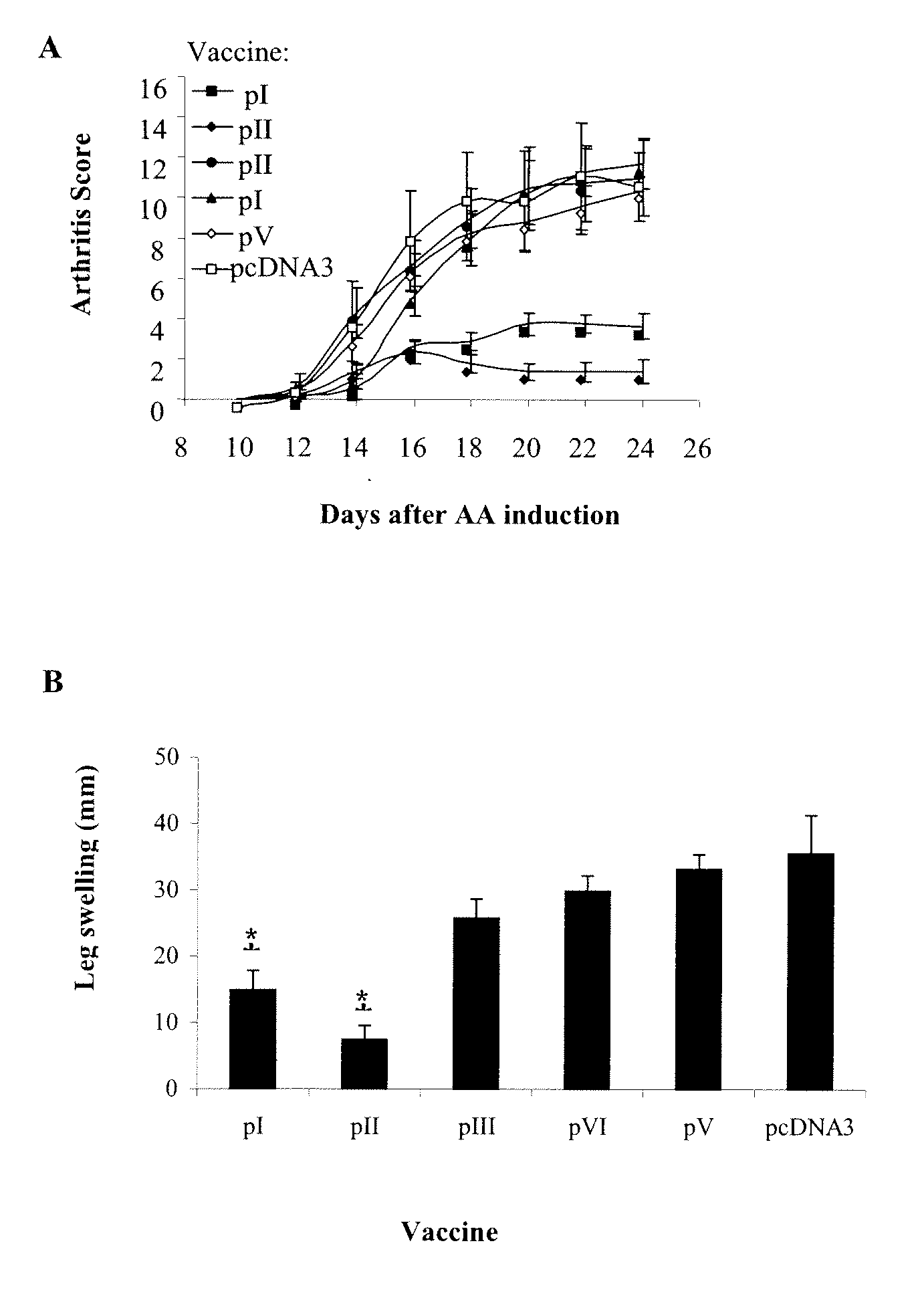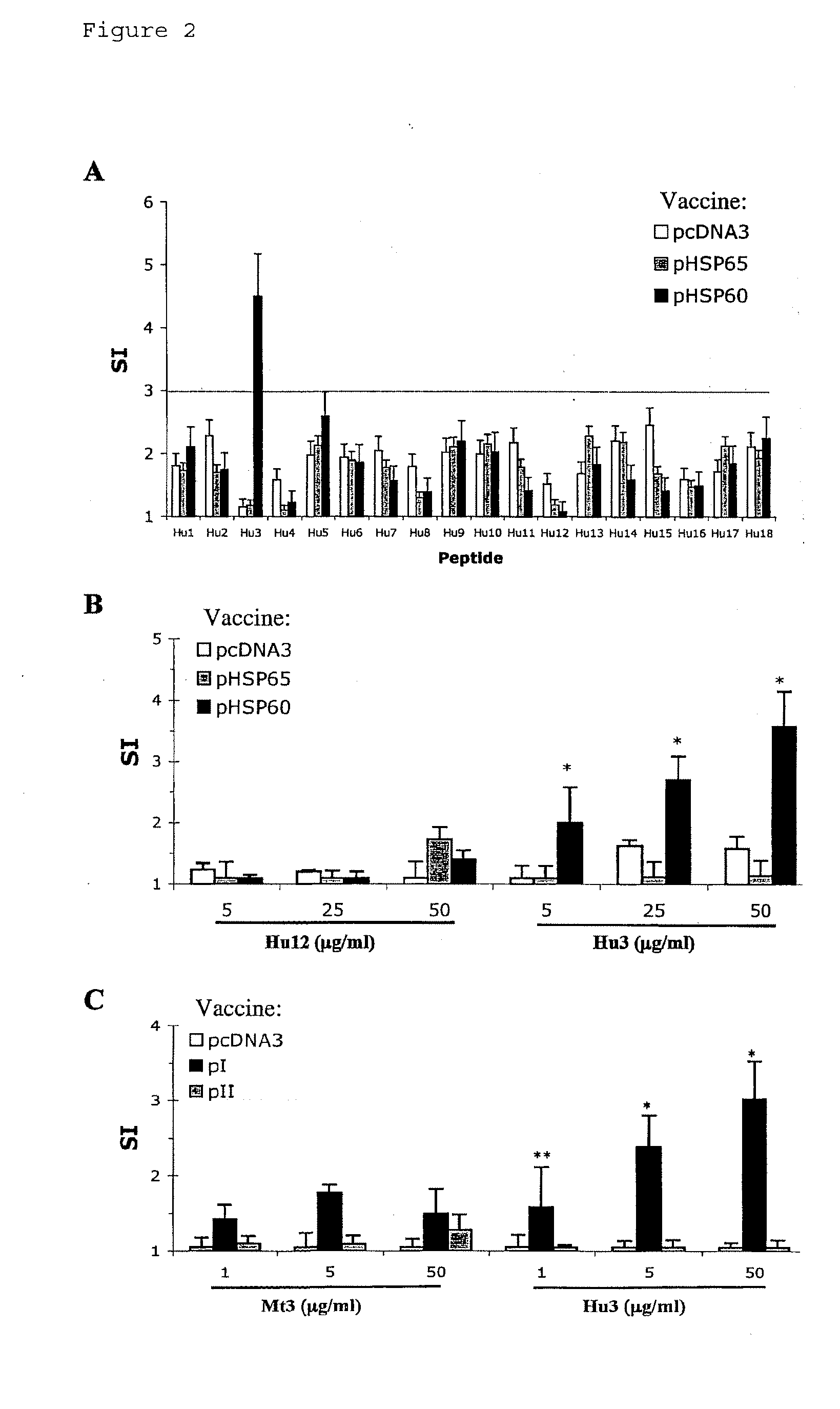DNA vaccines encoding heat shock proteins
a technology of heat shock protein and dna vaccine, which is applied in the direction of immunological disorders, antibody medical ingredients, peptide/protein ingredients, etc., can solve the problem of limiting the frequency of administration of the therapeutic composition needed to treat an animal, and achieve the effect of limiting the frequency of administration of the therapeutic composition
- Summary
- Abstract
- Description
- Claims
- Application Information
AI Technical Summary
Benefits of technology
Problems solved by technology
Method used
Image
Examples
example 1
HSP60 DNA Fragments Inhibit AA
[0102]To learn whether fragments of HSP60 DNA could inhibit AA, the cDNA corresponding to the human hsp60 gene was divided into five fragments, each with a 30 pb overlap, and each was cloned into the pcDNA3 vector (Table II). In this way, five constructs corresponding to HSP60-derived fragments were generated overlapping by 10 aa: pI, aa 1-140; pII, aa 130-260; pIII, aa 250-410, pIV, aa 400-470 and pV, aa 460-540 (Table II). Lewis rats were vaccinated with one of the HSP60 fragment constructs or with pcDNA3 as a control, and AA was induced. FIG. 1A shows that the rats vaccinated with pI or pII manifested significantly decreased arthritis compared to rats vaccinated with constructs pIII, pIV or pV or with control pcDNA3. The protective effect of the vaccination with constructs pI and pII was also reflected by a significant reduction in ankle swelling (FIG. 1B), and by a reduction of the mean maximal score, which was lower in those rats vaccinated with pI...
example 2
In Vitro Proliferation of LNC Isolated from pHSP60- or PI-Vaccinated Rats in Response to Various HSP60 Peptides
[0103]To learn whether the suppression of AA by DNA vaccination with pHSP60, pI or pII was associated with T-cell reactivity to a specific HSP60 epitope, the proliferation (Stimulation Index, SI) of LNC isolated from pHSP60-vaccinated rats was studied in response to a panel of overlapping peptides spanning the region of human HSP60 encoded by pI and pII (aa 1-275; Table I). Controls were LNC prepared from rats vaccinated with pcDNA3 or pHSP65 and challenged with Mt suspended in IFA to induce AA. FIG. 2A shows that only peptide Hu3 (aa 31-50 of human HSP60) induced a significant response in LNC taken from pHSP60-vaccinated rats; cells prepared from pHSP65 or pcDNA-vaccinated rats did not respond to Hu3. Note that the sequence of the HSP60 protein in the region 31-50 is identical in rat and human HSP60; thus Hu3 is a self-peptide (Table III). FIG. 2B shows a dose-dependant pr...
example 3
Peptide Hu3 Inhibits AA
[0104]To establish a link between the immune response to Hu3 and prevention of AA, rats were vaccinated with Hu3, or with its mycobacterial counterpart Mt3 (Table III) or with Hu12 (Table I) as controls. Each rat received a single i.p. dose of 100 μg of peptide in IFA seven days (day −7) before the induction of AA (day 0). FIG. 3A shows that the Hu3-vaccinated rats developed significantly decreased disease compared to non-immunized rats or rats vaccinated with PBS, Hu12 or Mt3. This reduction in AA was also reflected by a significant reduction in ankle swelling (14.2±4.7 in Hu3-vaccinated rats vs 32.2±3.5 in PBS / IFA-vaccinated rats, p=0.02; FIG. 3B). Therefore, vaccination with Hu3 prevents AA.
PUM
| Property | Measurement | Unit |
|---|---|---|
| diameter | aaaaa | aaaaa |
| diameter | aaaaa | aaaaa |
| diameter | aaaaa | aaaaa |
Abstract
Description
Claims
Application Information
 Login to View More
Login to View More - R&D
- Intellectual Property
- Life Sciences
- Materials
- Tech Scout
- Unparalleled Data Quality
- Higher Quality Content
- 60% Fewer Hallucinations
Browse by: Latest US Patents, China's latest patents, Technical Efficacy Thesaurus, Application Domain, Technology Topic, Popular Technical Reports.
© 2025 PatSnap. All rights reserved.Legal|Privacy policy|Modern Slavery Act Transparency Statement|Sitemap|About US| Contact US: help@patsnap.com



